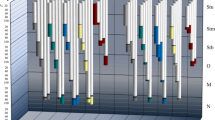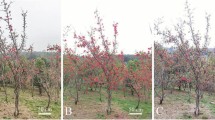Abstract
The study of pollen performance in vivo of four self-incompatible sweet cherry cultivars—‘Karina’, ‘Kordia’, ‘Regina’ and ‘Summit’ was performed. The results were considered in the context of climatic conditions of West Serbia, bearing in mind increased frequency of seasons with higher temperatures during the flowering. Each cultivar was used as polleniser and pollinated cultivar, and together with the open pollination variant, a total of 16 combinations were analysed during the three-year period. The effect of variability factors on pollen tube growth efficiency occurred as a common impact of polleniser, its requirement to flowering temperatures, the influence of pollinated cultivar on pollen performance, and the response of male–female relations to air temperature. ‘Summit’ induced the highest pollen tube number, while the pollen tube number of ‘Kordia’ was the lowest. Higher temperatures during the flowering have caused a decrease in the number of pollen tubes in ‘Kordia’ and ‘Karina’, and increase of their number in ‘Regina’ and ‘Summit’ as pollenisers. The genotype-dependent response of pollenisers in terms of air temperature during the flowering has not consistently manifested, and was partially modified by the influence of the pollinated cultivar. The main tendencies were more apparent in the ‘borderline cases’, i.e. in pollination of cultivars having diametrically opposite requirements, than in those of cultivars having similar requirements regarding the flowering temperature.




Similar content being viewed by others
References
Alburquerque N, Burgos L, Egea J (2002) Variability in the developmental stage of apricot ovules at anthesis and its relationship with fruit set. Ann Appl Biol 141:147–152
Alburquerque N, Burgos L, Sedgley M, Egea J (2004) Contributing to the knowledge of the fertilisation process in four apricot cultivars. Sci Hortic 102:387–396
Anvari SF, Stösser R (1978) Eine neue fluoreszenmikroskpische methode zur beurteilung der befruchtungsfähigkeit der samenanlagen bei Prunus. Z Pflanzenzuchtung 81:333–336
Arbeloa A, Herrero M (1987) The significance of the obturator in the control of pollen tube entry into the ovary in peach (Prunus persica). Ann Bot 60:681–685
Bargioni G (1996) Sweet cherry scions: Characteristics of the principal commercial cultivars, breeding objectives and methods. In: Webster AD, Looney NE (eds) Cherries: crop physiology, production and uses. CAB International, Wallingford, pp 73–112
Bošković R, Tobutt KR (1996) Correlation of stylar ribonuclease zymograms with incompatibility alleles in sweet cherry. Euphytica 90:245–250
Cachi AM, Wünsch A (2011) Characterization and mapping of non-S gametophytic self-compatibility in sweet cherry (Prunus avium L.). J Exp Bot 62:1847–1856
Cerović R (1997) Sour cherry fertilization biology. Endowment Andrejević, Belgrade
Cerović R, Ružić Đ (1992a) Senescence of ovules at different temperatures and their effect on the behaviour of pollen tubes in sour cherry. Sci Hortic 51:321–327
Cerović R, Ružić Đ (1992b) Pollen tube growth in sour cherry (Prunus cerasus) at different temperatures. J Hortic Sci Biotech 67:333–340
Cerović R, Ružić Đ, Mićić N (2000) Viability of plum ovules at different temperatures. Ann Appl Biol 137:53–59
Chmielewski FM, Müller A, Bruns E (2004) Climate changes and trends in phenology of fruit trees and field crops in Germany, 1961–2000. Agr Forest Meterol 121:69–78
Đorđević M, Cerović R, Nikolić D, Radičević S (2010) Unusual behaviour of growing pollen tubes in the ovary of plum culture (Prunus domestica L.). Arch Biol Sci 62:137–142
Đorđević M, Cerović R, Nikolić D, Radičević S, Lukić M (2012) Pollen tubes growth in the plum pistils in relations to initial fruit set. J Mt Agric Balk 15:726–733
Egea J, Burgos L (2000) Ovule differences between single-kernelled and double-kernelled fruits in almond (Prunus dulcis). Ann Appl Biol 136:291–295
Erez A, Yablowitz Z, Korcinski R (1998) Greenhouse peach growing. Acta Hortic 465:593–600
Erez A, Yablowitz Z, Korcinski R, Zilberstaine M, Fokkema NJ (2000) Grenhouse-growing of stone fruits: effect of temperature on competing sinks. Acta Hortic 513:417–425
Galleta GJ (1983) Pollen and seed management. In: Moore JN, Janick J (eds) Methods in fruit breeding. Purdue University Press, West Lafayette, pp 23–47
Granger AR (2004) Gene flow in cherry orchards. Theor Appl Genet 108:497–500
Hedhly A, Hormaza JI, Herrero M (2003) The effect of temperature on stigmatic receptivity in sweet cherry (Prunus avium L.). Plant Cell Environ 26:1673–1680
Hedhly A, Hormaza JI, Herrero M (2004) Effect of temperature on pollen tube kinetics and dynamics in sweet cherry, Prunus avium (Rosaceae). Am J Bot 91:558–564
Hedhly A, Hormaza JI, Herrero M (2005) Influence of genotype–temperature interaction on pollen performance. J Evol. Biol 18:1494–1502
Hedhly A, Hormaza JI, Herrero M (2007) Warm temperatures at bloom reduce fruit set in sweet cherry. J Appl Bot Food Qual 81:158–164
Hedhly A, Hormaza JI, Herrero M (2008) Global warming and sexual plant reproduction. Trends Plant Sci 14:30–36
Hedhly A, Hormaza JI, Herrero M (2009) Flower emasculation accelerates ovule degeneration and reduces fruit set in sweet cherry. Sci Hortic 119:455–457
Hegashiyama T, Yabe S, Sasake N, Nishimura Y, Miyagishima S, Kuroiwa H, Kuroiwa T (2001) Pollen tube attraction by sinergid cell. Science 293:1480–1483
Herrero M (2001) Ovary signals for directional pollen tube growth. Sex Plant Reprod 14:3–7
Herrero M, Hormaza JI (1996) Pistil strategies controlling pollen tube growth. Sex Plant Reprod 9:343–347
Hormaza JI, Herrero M (1996) Dynamics of pollen tube growth under different competition regimes. Sex Plant Reprod 9:153–160
Hormaza JI, Herrero M (1999) Pollen performance as affected by the pistilar genotype in sweet cherry (Prunus avium L.). Protoplasma 208:129–135
Kho YO, Baër J (1971) Fluorescence microscopy in botanical research. Zeiss Info 76:54–57
Kozai N, Beppu K, Mochioka R, Boonprakob U, Subhadrabandhu S, Lillecrapp AM, Wallwork MA, Sedgley M (1999) Female and male sterility cause low fruit set in a clone of the ‘Trevatt’ variety of apricot (Prunus armeniaca L.). Sci Hortic 82:255–263
Marchese A, Bošković RI, Caruso T, Raimondo A, Cutuli M, Tobutt KR (2007) A new self-compatibility haplotype in the sweet cherry ‘Kronio’, S5’, attributable to a pollen-part mutation in the SFB gene. J Exp Bot 58:4347–4356
Milatović D, Đurović D, Đorđević B, Vulić T, Zec G (2011) Pomological properties of new sweet cherry cultivars in high density planting.In: Proceedings of the 3rd conference innovations in fruit growing, Belgrade, Republic of Serbia, pp 163–171
Mulcahy DL (1979) The rise of angiosperms: a genecological factors. Science 206:20–23
Nava GA, Dalmago GA, Bergamaschi H, Paniz R, Santos RP, Marodin GA (2009) Effect of high temperatures in the pre-blooming and blooming periods on ovule formation, pollen grains and yield of ‘Granada’ peach. Sci Hortic 122:37–44
Pirlak L (2002) The effects of temperature on pollen germination and pollen tube growth of apricot and sweet cherry. Gartenbauwissenschaf 67:61–64
Postweiler K, Stösser R, Anvari SF (1985) The effect of different temperatures on the viability of ovules in cherries. Sci Hortic 25:235–239
Preil W (1970) Observing of pollen tube in pistil and ovarian tissue by means of fluorescence microscopy. Zeiss Info 75:24–25
Radičević S, Cerović R, Glišić I, Mitrović O (2009) Ripening time and biochemical composition of fruits of introduced sweet cherry cultivars (Prunus avium L.). J. Pomol 43:45–51
Radičević S, Cerović R, Mitrović M, Mitrović O, Lukić M, Marić S, Milošević N (2011a) Biological properties of introduced sweet cherry cultivars (Prunus avium L.). In: Proceedings of the 3rd conference innovations in fruit growing, Belgrade, Republic of Serbia, pp 173–181
Radičević S, Marić S, Cerović R, Đorđević M (2013) Assessment of self-(in)compatibility in some sweet cherry (Prunus avium L.) genotypes. Genetika 45:939–952
Schuster M (2012) Incompatible (S-) genotypes of sweet cherry cultivars (Prunus avium L.). Sci Hortic 148:59–73
Schuster M, Flachowsky H, Köhler D (2007) Determination of self-incompatible genotypes in sweet cherry (Prunus avium L.) accessions and cultivars of the German Fruit Gene Bank and from private collections. Plant Breed 126:533–540
Sonneveld T, Tobutt KR, Vaughan SP, Robbins TP (2005) Loss of pollen-S function in two self-compatible selections of Prunus avium is associated with deletion/mutation of an S haplotype-specific F-box gene. Plant Cell 17:37–51
Stösser R, Anvari SF (1982) On the senescence of ovules in cherries. Sci Hortic 16:29–38
Wertheim SJ (1996) Methods for cross pollination and flowering assesment and their interpretation. Acta Hortic 423:237–241
Winsor JA, Stephenson AG (1995) Demographics of pollen tube growth in Cucurbita pepo. Can J Bot 73:583–589
Yamane H, Ikeda K, Ushijama K, Sassa H, Tao R (2003) A pollen-expressed gene for a novel protein with an F- box motif that is very tightly linked to a gene for S-RNase in two species of cherry, Prunus cerasus and P. avium. Plant Cell Physiol 44:764–769
Acknowledgments
This work was conducted under Research Project TR-31064: Development and preservation of genetic potential of temperate zone fruits, supported by the Ministry of Education, Science and Technological Development of the Republic of Serbia.
Author information
Authors and Affiliations
Corresponding author
Rights and permissions
About this article
Cite this article
Radičević, S., Cerović, R., Nikolić, D. et al. The effect of genotype and temperature on pollen tube growth and fertilization in sweet cherry (Prunus avium L.). Euphytica 209, 121–136 (2016). https://doi.org/10.1007/s10681-016-1645-y
Received:
Accepted:
Published:
Issue Date:
DOI: https://doi.org/10.1007/s10681-016-1645-y




